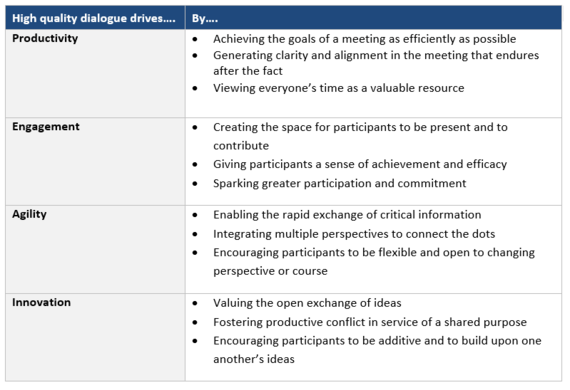Co-authored by Shani Harmon.
While much has been written about the "meeting problem," too little of the prescriptions are focused on the defining factor of a meeting's value: the quality of the dialogue. It's almost as if we've forgotten that the reason we reserved a conference room, set up a dial-in number, and played calendar roulette with a dozen people was so that we could get together and talk about something that really matters for our business performance...
Dialogue sounds so lofty and abstract. What are we really talking about?
Let's start with what it's not. And by way of example, we offer this great 50 second clip from the Sandra Bullock movie While You Were Sleeping:
We've all been in meetings that were too much like that dinner table conversation about mashed potatoes and tall men. You know - the ones where everyone is having their own conversation....
Dialogue is not the same as other common forms of communication such as discussion, debate, or diatribe:
- Discussion, which shares the same etymological root as "percussion" and "concussion," is more like a game of ping-pong. Participants hit their solid ideas and well-defended positions back and forth. The consequence is that people believe they had a real exchange, but nothing changes as a result.
- Debate is the opposite of dialogue. Participants listen to find the holes in each other's ideas and speak to affirm their own. It avoids integration and the goal is to win the argument.
- Diatribe, in which one person holds forth at length, while others roll their eyes and glance at their smartphones is the stuff that most meetings are made of.
Ok, so if it's not any of that, what is dialogue and how will I know it when I see it?
In the simplest terms, dialogue is the art of thinking together to reach new insights, co-create, make effective group decisions, and problem-solve. Its purpose is to create shared, integrated meaning, which leads to wiser and more effective collective action.
Here are the most essential characteristics of high-quality dialogue:
- Focused on something that matters: it has a center, not sides
- Authentic: The environment invites participants to be open -- to say what's true without making others wrong, and to engage fully. Participants have the wisdom and courage to say exactly what they think
- Integrative: Participants listen to expand their understanding and contribute to advance the collective wisdom
- Informed: The necessary data, insights, context are present and respected
- Conclusive: the group gets somewhere new as a result of the dialogue
Honestly, high quality dialogue sounds like a "nice-to-have" Why does it matter?
It is widely acknowledged that in today's knowledge-based economy, sustainable competitive advantage comes through organizational learning. Learning is fostered through reflecting together, making new connections, and being able to take coordinated action - all outcomes of high quality dialogue. Therefore, high quality dialogue matters because it fuels four things every organization cares about: productivity, engagement, agility, and innovation. Here's how:
Those outcomes seem important - so why is high quality dialogue the exception rather than the rule?
In many organizations, meetings have become the end rather than a means. When our calendars are overloaded, we feel important and necessary. Many people have lost sight of the fundamental purpose of meeting - to come together to produce high quality dialogue. This oversight is exacerbated by organizational cultures that reward mindless inclusion, one-way, top-down information delivery, or confrontational, unproductive debate. That's why simple "tips and tricks" do little to improve the situation - they're aiming at the symptoms, not the root cause.
I'm convinced. Now what?
If you're committed to raising the quality of dialogue in your team or organization, here are some ways to get started:
- Bring attention to this issue with your team - see if you can get everyone to agree to raise the bar
- Make sure every meeting has a "center" -- a clear purpose that is understood by all
- Elevate the quality of your own contribution. Find opportunities to integrate multiple perspectives or summarize the progress the group has made so far
- End every meeting with an assessment of how you did as a group on producing the desired outcome, strengthening trust and relationship, and learning from one another. We use a simple 5 point scale and capture results on a flipchart.
Let us know your strategies for elevating the quality of dialogue in your organization.

